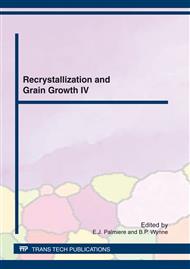p.853
p.854
p.860
p.866
p.872
p.877
p.883
p.889
p.895
Effect of Matrix Size and Neighbour Sites on Microstructure Evolution in 3D Monte Carlo Grain Growth Simulation
Abstract:
Grain size is an important microstructural feature of materials; it contributes to its mechanical and physical properties. Quantitative information of three-dimensional topological evolution during the three-dimensional normal grain growth process is very rare. In this work, an isothermal Monte Carlo procedure is applied to study the kinetics of normal grain growth in three dimensions using the Monte Carlo technique. Monte Carlo simulation of the grain growth in polycrystalline materials employed maps the microstructure onto a discrete lattice. It consists in evaluation of potential energy of a lattice point. Therefore, the choice of the simulation parameters can affect the grain growth characteristics. We attempted to define specific simulation parameters for the three dimensional MC simulation of grain growth using theses lattices. The parameters include the choice of the lattice symmetry, the pixels number and the number of the nearest neighbor lattice sites in the calculation of the system energy. The goal of these computer simulations is to provide insights on the simulated structure and to analyze the grain growth kinetics for the 3D domain through several 2D cross-sections. Compact microstructures were developed and the first results show that the lattice symmetry and the neighbours number have a fundamental influence on the results of grain growth simulation. The saturation is too rapid with only the consideration of the 1st neighbours while acceptable similar evolutions are obtained for the 2nd or 3rd neighbours consideration. Grain size evolution obeys the power law kinetics for the 2D cross-section confirming the quasi-steady state of the 3D normal grain growth. The highest grain growth velocity and grain size were obtained at the cross-sections of the heart of microstructures. One other noted information is the existence of a minority of grains which continue to grow slowly leading up to the abnormal grain growth.
Info:
Periodical:
Pages:
872-876
Citation:
Online since:
April 2012
Authors:
Price:
Сopyright:
© 2012 Trans Tech Publications Ltd. All Rights Reserved
Share:
Citation:


